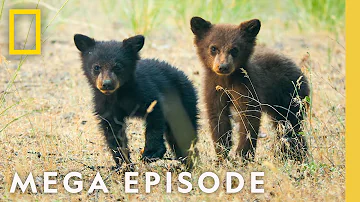
Keeshond
Canis lupus familiaris

Meet the Keeshond
The Keeshond is a medium-sized dog breed known for its thick, plush coat, distinctive 'spectacles' around the eyes, and expressive face. Originally bred as a companion and watchdog on Dutch barges, the Keeshond is highly sociable, intelligent, and affectionate, making it an excellent family pet. Its luxurious silver and black fur, curled tail, and alert demeanor contribute to its striking appearance. The breed is renowned for its cheerful nature and adaptability, thriving in both urban and suburban environments.
Classification
Mammal
Habitat
Domestic, originally bred for life on river barges and in temperate climates
Diet
Omnivore
Lifespan
12-15 years
Conservation
Least Concern
Weight
16-20 kg (35-44 lbs)
📖Fascinating Facts
Distinctive Markings
Keeshonden are easily recognized by their unique 'spectacles'—dark lines and shading around their eyes, accentuating their expressive faces.
Barge Dog Heritage
The breed was highly valued as a watchdog and companion on Dutch river barges, helping guard property and alert owners to danger.
Loyal Family Companion
Keeshonden are known for their affectionate, gentle temperament and strong bond with families, making them excellent pets for children.
📋Detailed Description
The Keeshond is a robust, medium-sized member of the Spitz family, typically weighing 16–20 kg (35–45 lbs) and standing 43–46 cm (17–18 in) at the withers. Its most distinctive anatomical features include a dense double coat: a woolly, insulating undercoat and a longer, straight guard coat that forms a pronounced ruff around the neck and feathering on the legs and tail. The breed’s expressive face is accentuated by unique 'spectacles'—shaded markings and lines around the eyes—contributing to its alert, intelligent appearance. Keeshonden have compact, well-proportioned bodies, erect triangular ears, and a tightly curled tail carried high over the back. Their teeth form a scissors bite, and their eyes are medium-sized, dark, and almond-shaped, conveying a lively and inquisitive demeanor. Behaviorally, Keeshonden are highly social, forming strong bonds with family members and displaying pronounced watchdog instincts without aggression. They are known for their vocalizations, often alerting owners to unfamiliar activity. As a breed originally developed for life on Dutch river barges, they are agile, adaptable, and thrive in close human company. Their moderate energy levels and intelligence make them well-suited to a variety of activities, from obedience and agility to therapy work. Keeshonden are generally long-lived, with an average lifespan of 12–15 years, and are considered a healthy breed with few hereditary disorders.
💡 Did you know?
The Keeshond was once known as the 'Dutch Barge Dog' due to its popularity as a companion and watchdog on canal boats in the Netherlands.
🔬Research & Sources
Wikipedia Summary
The Keeshond is a medium-sized dog with a plush, two-layer coat of silver and black fur with a ruff and a curled tail. Their closest relatives are the German spitzes such as the Großspitz, Mittelspitz, Kleinspitz, Zwergspitz (Dwarf-Spitz) or Pomeranian.
Last Modified: 11/6/2024
🎭Behavior & Social Structure
Keeshonden are renowned for their sociable, affectionate, and people-oriented temperament. They are highly attuned to human emotions and thrive on companionship, often following their owners from room to room. As vigilant watchdogs, they are quick to bark at unfamiliar sounds or visitors, but are rarely aggressive—preferring to alert rather than confront. Their play behavior is exuberant, and they often engage in interactive games with both humans and other dogs. Keeshonden are intelligent and quick learners, responding well to positive reinforcement training methods. They require regular mental stimulation and moderate daily exercise, such as brisk walks and play sessions, to prevent boredom and associated behavioral issues. In multi-dog households, they tend to be amicable and display a stable social hierarchy, rarely showing dominance aggression. Their feeding behavior is typical of domestic dogs, with a preference for high-quality, balanced diets; they may be prone to overeating if not monitored. Keeshonden are generally gentle with children and tolerant of other pets, making them excellent family companions.
👶Reproduction & Life Cycle
Keeshonden reach sexual maturity between 8 and 12 months, though responsible breeding is recommended after 18 months of age to ensure full physical and behavioral maturity. The breed exhibits no marked seasonality in estrus cycles, with females typically coming into heat twice a year. Mating is usually preceded by courtship behaviors such as play bowing and mutual grooming. Gestation lasts approximately 63 days, after which litters of 3–8 puppies are born. Neonates are altricial, requiring intensive maternal care. The dam provides warmth, nutrition, and grooming, while the sire may participate in socializing the pups if present. Weaning begins at 3–4 weeks, with full transition to solid food by 6–8 weeks. Breeders emphasize early socialization, as Keeshonden benefit from exposure to varied stimuli during the critical socialization window (3–14 weeks). The breed is not known for reproductive complications, though ethical breeding practices prioritize screening for hereditary conditions such as hip dysplasia and patellar luxation.
🛡️Adaptations & Survival
The Keeshond’s thick double coat is a key adaptation for insulation against harsh, temperate climates, particularly suited to the damp, windy conditions of river barges and northern Europe. The outer guard hairs repel water and dirt, while the dense undercoat conserves body heat. Their compact, agile build allows for easy movement in confined spaces, and their curled tail provides additional warmth when curled up. The breed’s acute hearing and keen sense of smell are well-developed, supporting their role as alert watchdogs. Behaviorally, their strong social attachment to humans is an evolutionary specialization, reflecting centuries of selection for companionship and cooperative living. Their vocal tendencies serve as an effective alarm system, while their intelligence and trainability are adaptive traits for complex social environments.
🎨Cultural Significance
The Keeshond holds a prominent place in Dutch history and culture, often referred to as the 'Smiling Dutchman.' In the late 18th century, the breed became a symbol of the Dutch Patriot political party, led by Cornelis (Kees) de Gyselaer, from whom the breed derives its name. Keeshonden were favored as companions and watchdogs on river barges and in merchant households, valued for their loyalty, intelligence, and approachable demeanor. Their distinctive appearance and cheerful personality have made them popular in art, literature, and as mascots. Today, the Keeshond is celebrated in dog shows and as a therapy and assistance animal, reflecting its enduring versatility and appeal.
🔬Recent Research & Discoveries
Recent genetic studies have confirmed the Keeshond’s close relationship with other German Spitz breeds, including the Wolfspitz and Pomeranian, supporting historical accounts of shared ancestry. Ongoing research focuses on the breed’s genetic diversity, with international breed clubs collaborating to monitor and manage hereditary health conditions. Studies on canine cognition have highlighted the Keeshond’s advanced problem-solving abilities and social intelligence, making them subjects of interest in research on canine-human communication. Veterinary research continues to monitor the prevalence of breed-specific conditions, with emphasis on early detection and preventive care. The Keeshond’s adaptability and sociability have also made it a model for studies on the effects of domestication on canine behavior.
🎥Wildlife Videos

Keeshond Pup Makes Friends In The Farm | Too Cute
These keeshond puppies are still learning how to play in new environments, but when they see the local farm life their social ...
Animal Planet

Wildlife Stories: Nature’s Greatest Engineers | Free Documentary Nature
Wildlife Stories: Build or Die | Free Documentary Nature Wildlife Stories: Nature's Master Builders | Free Documentary Nature ...
Free Documentary - Nature

Wild Colombia - Fantastic Creatures | The Lost Eden | Free Documentary Nature
Wild Colombia - Fantastic Creatures | The Lost Eden | Free Documentary Nature Watch 'Wild Colombia Revealed' here: ...
Free Documentary - Nature

The Wonder of America's National Parks | MEGA EPISODE Season 1 Full Episode
America's National Parks depicts the adventure, beauty and wonder of natural spaces. Each park is a valuable and important ...
National Geographic

The Incredible Wildlife Living At Our Equator | Equator Specials
The sun shines most powerfully at the Equator, here it is able to power extraordinary life. From the large trees covering the ...
All Out Wildlife

WILD SIBERIA | Survival Secrets of the Frozen Wilderness | Animal documentary
Welcome to "WILD SIBERIA | Survival Secrets of the Frozen Wilderness" – where we'll explore the extraordinary survival journey ...
WILD NATURE - Nature animal documentary
🌍Habitat Information
The Keeshond typically inhabits Domestic, originally bred for life on river barges and in temperate climates environments. Keeshonds have adapted to their environments with specialized features and behaviors.
Primary Habitat:
Domestic, originally bred for life on river barges and in temperate climates
More detailed habitat information will be available soon.
🛡️Conservation Status
The Keeshond is currently classified as Least Concern. Conservation efforts are crucial for preserving this species for future generations.
Common Threats:
- 🏠Habitat loss and fragmentation
- 🌡️Climate change impacts
- 🎯Hunting and poaching
- 🏭Human-wildlife conflict
⚠️Threats & Conservation Challenges
As a domestic breed, the Keeshond faces few natural threats, but several challenges persist. Overbreeding and irresponsible breeding practices can lead to increased prevalence of hereditary health issues, such as hip dysplasia, progressive retinal atrophy, and epilepsy. Obesity is a growing concern due to their propensity for overeating and relatively modest exercise requirements. In some regions, popularity fluctuations have led to reduced genetic diversity, increasing the risk of inherited disorders. While the breed is not endangered and is classified as 'Least Concern,' maintaining genetic health and responsible ownership are ongoing priorities. Urbanization and changing lifestyles may also impact the breed’s traditional roles and exercise opportunities.
🔬Scientific Classification
Scientific Name
Canis lupus familiaris
Classification Hierarchy
🔍 About Taxonomic Classification
Taxonomic classification is a hierarchical system used by scientists to classify and organize living organisms based on shared characteristics and evolutionary relationships.
The system moves from broad categories (Kingdom) to increasingly specific ones, with each animal's scientific name typically consisting of its Genus and species.
📝Community Notes
Share your observations and insights about the Keeshond with our community of wildlife enthusiasts.
Join Our Community
Sign in to share your observations and connect with fellow wildlife enthusiasts.
Sign In to ContributeNo community notes yet
Be the first to share your observations about the Keeshond!
Explore Keeshond
Select a tab above to learn more about this amazing animal.
📸Photo Gallery
No photos available for this animal yet.
🌟Discover More Wildlife
Continue your journey of discovery with more fascinating animals from our database
